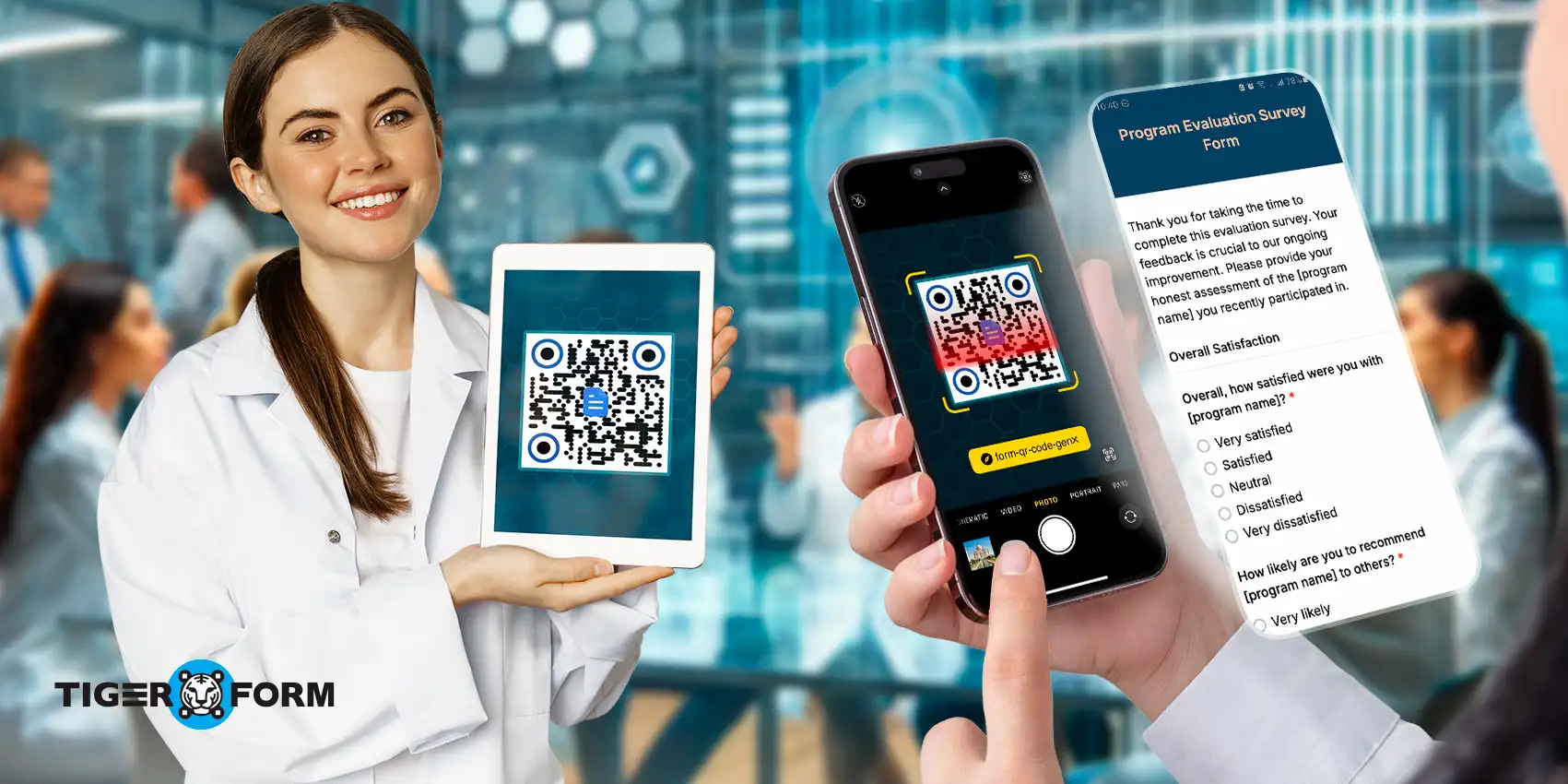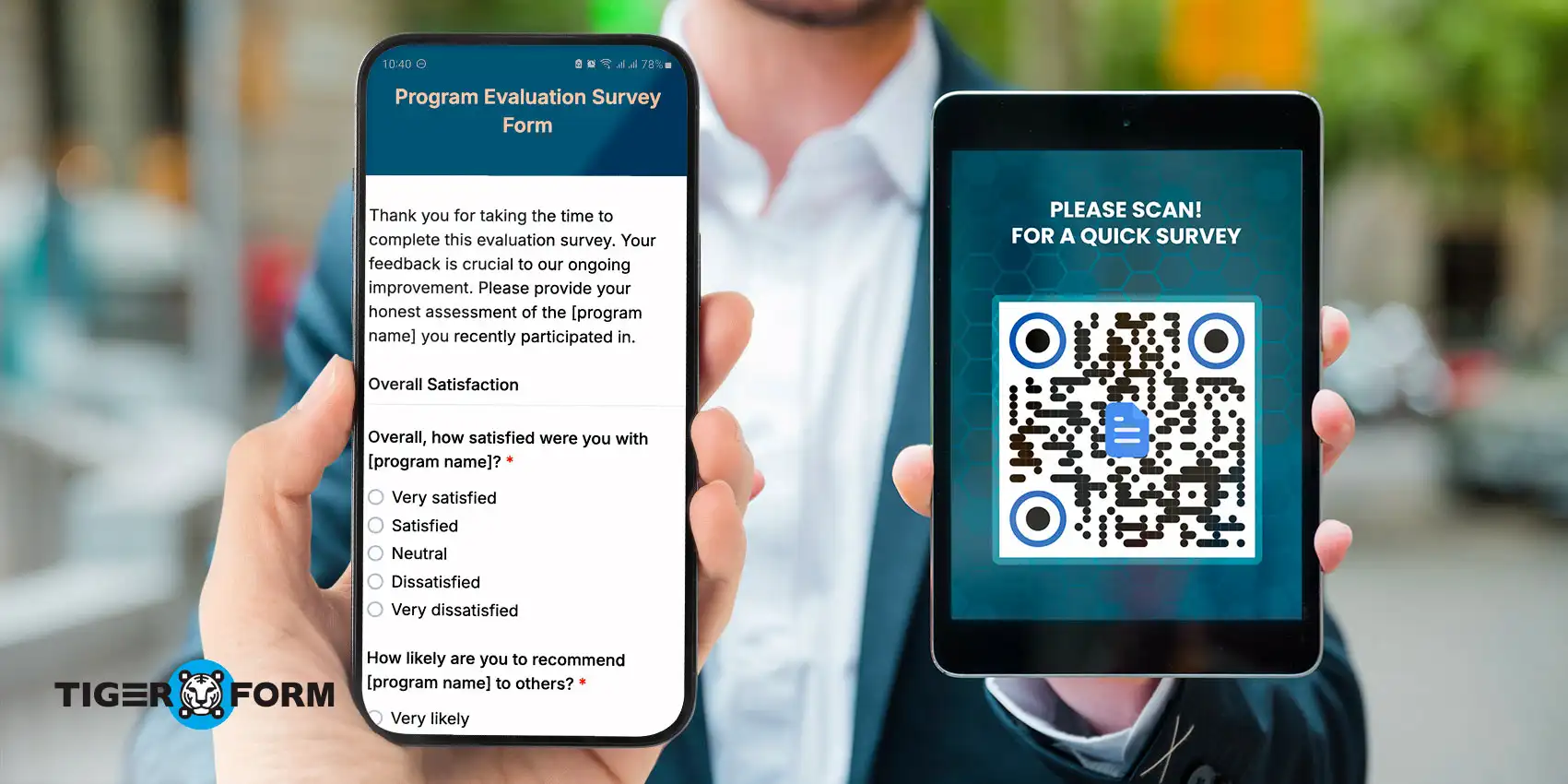
When it comes to gathering information—whether trying to improve customer service or discover new insights—data collection methods are key. However, with so many ways of collecting data, it can get slightly overwhelming.
How do you know which method to choose? And, with everything shifting to digital, what tools should you use to make this process easier?
There’s no need to stress. We’ll discuss seven data collection approaches, learn about smart data collection tools, and see how QR forms simplify data gathering.
Understanding data collection methods
Data-gathering methods are simply the processes or techniques used to gather and measure information from various sources. The information can be quantitative (think numbers, stats, and metrics) or qualitative (opinions, experiences, or behaviors).
These methods help you collect the data you need to make informed decisions. Whether you’re collecting feedback on a customer service experience, evaluating employee performance, or gathering insights for a market research report, having the right data collection approach in place is essential.
For example, a customer feedback form for financial services can help assess client satisfaction with banking, loans, or investment support.
Types of data collection methods
By source
Primary data collection
Is where you gather data directly from the source for the specific research objective. A firsthand source that will allow you to choose your own variables, decide the data collection flow, and guarantee that all aligns with your study’s structure.
You can use primary methods when your topic requires context-specific, up-to-date, or unique insights that secondary sources cannot provide. This is common for exploratory research, new trends, or when testing a novel intervention. For instance, answers from structured interviews to collect first-hand perspectives are a primary type of data collection method.
Secondary data collection
Relies on information that has already been collected by others and is then reanalyzed for new insights. According to a study by Wickham, RJ. published in PubMed Central, this is considered the most cost-effective and time-efficient method.
Secondary sources are usually analysed for historical analysis, trend tracking, or supplementing primary data. For instance, when the goal of the study is to examine housing market trends, a researcher might analyze national census data or published housing price indexes to make conclusions.
By technique
Qualitative research
As the name suggests, the quality data collection approach deals with non-numerical data. Instead, it examines qualities of subjects such as emotions, opinions, or social dynamics. This approach is used when you want to get results in varying viewpoints or understand motivations or complex relationships.
Use qualitative methods when you need deep context or to explore issues that cannot be easily quantified. They are often used in early stages of research or to complement quantitative findings for a mixed-methods study.
Quantitative research
Quantitative methods gather numerical data that can be measured and analyzed statistically. They are suited for identifying patterns, testing hypotheses, and producing generalizable results.
Use quantitative approaches when you need measurable data that can be compared, modeled to confirm hypotheses. Note that large sample sizes and structured instruments improve reliability.
7 methods for data collection (with examples)
When you’re gathering data, choosing the right form of data collection can make a big difference. Let’s break down seven common methods with some real-world examples of data collection and a look at the benefits and drawbacks of each.
1. Surveys
Surveys are one of the most common and flexible data collection approaches. They allow you to ask specific questions to a large group of people and collect data quickly.
Survey is done by distributing structured questionnaires that contain a mix of closed and open-ended questions, either online, by phone, or face-to-face. According to SurveySparrow’s statistical compilations, surveys with less to 7 fields tends to be completed more. Specifically, 1-3 fields yield 83.34% completion rate.
Data collection examples:
- Customer satisfaction surveys
- Employee engagement surveys
- Market research surveys
| Pros | Cons |
| • Cost-effective (especially if you use digital tools like survey platforms).• Can reach a large number of people in a short time.• Can be tailored to focus on specific questions. | • Response rates can be low, especially with long or poorly designed surveys.• Limited by the questions asked—participants can’t always explain their reasoning. |
2. Interviews
Interviews allow you to get deeper insights from your target recipients. They can be structured (with set questions), semi-structured (a mix of set and open-ended questions), or unstructured (more like a casual conversation).
With interviews, you directly talk and observe respondents’ body languages while hearing their idea thoughts or feelings. Many researchers record interviews so they can easily recall answers and conversations.
Data collection methods examples
- Job interviews
- Customer or client interviews for feedback
- Research interviews
| Pros | Cons |
| • Offers deeper insights—interviewees can elaborate on their answers.• Allows for follow-up questions and clarification. | • Time-consuming both for the interviewer and the interviewee.• Data analysis can be tricky, especially with large volumes of interview content. |
3. Observations
Observational method is a field data collection where researcher watch and record behaviors, interactions, or events as they naturally happen. Observation is done without asking people to explain themselves.
This method is particularly useful when you want to analyze natural behavior without relying on self-reporting or deciphering words. For this, field notes, checklists, or video recordings are often used to document findings.
Data collection examples:
- Observing how customers use your product in a retail setting
- Tracking employee workflows
- Researching market trends
| Pros | Cons |
| • Provides insights into actual behaviors, not just what people say they do.• Non-intrusive if done subtly. | • It can be time-consuming and difficult to quantify.• Observer bias is a risk—what one person notices may differ. |
4. Focus groups
Focus groups involve bringing together a small group of people to discuss specific topics, products, or services. This method encourages a lively exchange of ideas and participants often build on each other’s responses, revealing inputs that one-on-one interviews may not capture.
For example, a marketer might use a focus group to test reactions to a new product concept. Using recurring suggestions or unexpected concerns, product refinement may be done.
Data collection methods examples
- Feedback focus groups
- Focus groups for brand perception
- Testing new advertisements or marketing campaigns
| Pros | Cons |
| • Great for exploring ideas in-depth and brainstorming.• Group dynamics can trigger new insights and opinions. | • Not always representative of the larger population.• Participants can be influenced by dominant voices in the group, leading to biased data. |
5. Document analysis
Document analysis takes a different angle by examining existing records, reports, or other written materials to extract relevant information, clearly a secondary data collection approach. This method is practical when you need historical data or insights from established sources.
For example, researchers might review annual reports, meeting minutes, or archival documents to identify patterns or support emerging findings.
Data collection examples:
- Reviewing customer service logs
- Analyzing employee performance reviews
- Studying academic papers for research
| Pros | Cons |
| • Provides data from existing sources, saving time.• Useful for longitudinal studies (e.g., tracking changes over time). | • The data may not be as up-to-date as you need.• It can be tedious to analyze large volumes of documents. |
6. Transaction tracking
In contexts where customer behavior is central, transaction tracking is a practical method for gathering data on what people do during purchases or interactions with services. This method is particularly useful for businesses that want to understand customer buying patterns.
Commerce and retail marketers start transaction tracking by collecting details like purchase amounts, product types, and transaction times are recorded then analyzed for informed actions.
data collection methods examples:
- Online purchase tracking
- Retail point-of-sale (POS) data
- Monitoring subscription or renewal rates
| Pros | Cons |
| • Provides data from existing sources, saving time.• Useful for longitudinal studies (e.g., tracking changes over time). | • The data may not be as up-to-date as you need.• It can be tedious to analyze large volumes of documents. |
7. Online tracking
Online tracking involves monitoring online behavior, such as website visits, clicks, and social media interactions. This method is essential for understanding customer interests and engagement.
For instance, combined with tools like a customer engagement form for marketing or advertising, businesses can gather direct input alongside behavioral data through a data collection platform to refine their strategies.
Data collection examples:
- Website behavior tracking using Google Analytics
- App usage tracking via mobile analytics
- Monitoring online ad campaign performance
| Pros | Cons |
| • Provides instant insights into customer behavior.• Data can be easily visualized and analyzed. | • It may not always capture the full context behind a user’s actions.• Privacy concerns can arise if users are not fully informed about the data being collected. |
Smart tools for data collection that you can use

Methods and tools of data collection go hand in hand—while methods define how data is gathered, tools ensure the process is efficient, accurate, and organized. The right tools enhance each method, helping collect high-quality data that can be analyzed effectively.
If you’re looking for data collection tool examples, here are some essential tools that work alongside different collection methods:
Surveys/Questionnaire forms
Surveys and questionnaire forms help you gather data from many participants in an organized way. Whether it’s multiple-choice questions, open-ended queries, or ratings, these forms are a go-to for collecting structured data.
For example, a retail survey form might include a satisfaction rating and a short feedback section to understand customer experiences.
Interview guides/recorders
Interview guides help keep conversations focused while recording tools make transcribing and reviewing responses easier. These tools are essential for the interview, enabling organized and thorough data collection.
Observation checklists
Observation checklists track specific behaviors, actions, or events during an observation session. They can also be used to systematically record data in real-time, ensuring nothing important is missed.
Data logging tools
Data logging tools are useful for tracking ongoing activities or events over time. They help store and organize data, making it easier to monitor trends or patterns.
Experimental tools
Experimental tools are designed to assist researchers in controlled settings, where variables are manipulated to observe outcomes. These tools help gather data that test specific hypotheses, allowing researchers to measure the impact of certain factors in experiments.
Standardized analysis tools
Standardized analysis tools help researchers process and analyze data according to established methods. Data collection forms for research gather responses, which are then examined using these tools to ensure systematic and accurate interpretation.
QR code forms
This unique yet most innovative digital solution promotes contactless data collection process by directing respondents to forms with just a scan on QR codes. A tool that would be useful to simplify hassles in data and research process. Accordingly, census usability research reveals that, on average, users scan QR codes to access surveys in just 12.4 seconds and rate the experience as “extremely easy.
A online tool that can assist you in creating QR code-integrated forms is TIGER FORM. The platform provides an efficient way to collect responses and track data with its QR form generating capabilities.
How to simplify the data gathering procedure with QR forms
Data collection is a process of gathering and measuring information to analyze and make decisions. Usually, this involves using tools like surveys, checklists, or observation forms. But, these methods can be slow, and sharing or organizing the data isn’t always easy.
So, we have QR forms. With these, you can quickly access and fill out a form just by scanning a code without needing long links or paper forms. This makes collecting data easier and faster, especially in events, stores, or work sites.
Now, let’s learn how to create QR forms that would simplify the data collection process:
Step 1
Start by visiting a form QR code generator to create your form.
Step 2
Choose a template that fits your data collection method or create a new form based on your needs.
Step 3
Customize the form with relevant questions and adjust it to fit your goals.
Step 4
Preview your form to check for any errors and make necessary adjustments.
Step 5
Generate and customize your QR code to match your preferences, like adding a logo or changing colors.
Step 6
Share the QR code wherever your audience can easily scan it, such as at events or on-site locations.
Step 7
Use the built-in analytics tools to track scans and submissions, including data on when, where, and from which devices responses are coming. This feature allows you to gain deeper insights for more accurate research results.
Important considerations when choosing gathering methods

Research objective
What type of data are you trying to collect? Quantitative data (numbers) or qualitative data (opinions and experiences)?
Make sure the method you choose matches your goals. Qualitative methods like interviews or focus groups might work best if you need detailed insights. Quantitative methods like surveys or transaction tracking might be your go-to if you’re focused on tracking metrics.
Target population
Who are you collecting data from?
Your data collection should be tailored to your target audience to obtain the most accurate and relevant insights. In marketing research procedures, defining the right target population ensures that the data collected truly reflects consumer behavior and preferences.
Feasibility
Consider the accessibility of your participants and the resources you have.
- How easy is it to collect the data you need?
- Are participants easily reachable online, or do they require in-person contact?
- Will you collect the data over a short period, or is this a long-term process?
Ethical considerations
It’s important to protect your participants’ privacy and ensure informed consent is obtained. Be transparent about what data you’re collecting and how it will be used.
Following data collection best practices, such as anonymizing sensitive information, helps maintain confidentiality. Make sure participants are aware that they can withdraw at any time without consequences.
Budget and time constraints
Your available time and budget will impact the data collection approach you choose. Be realistic about what you can afford and how quickly you need the data.
Scalability
Can the method scale up if necessary?
Will the method still be efficient if your research grows or if you need to collect more data as your project progresses?
Data quality
While considering convenience, don’t overlook the quality of data each method provides. Some methods may be quicker but might result in lower-quality data. The better the data quality you collect, the more reliable your findings will be.
Technology compatibility
Some collection methods may require specific technology or tools to function properly. For example, online surveys require an internet connection, and observation checklists might be best supported by apps designed for data logging.
Real-time feedback
If you’re looking for immediate data insights, consider methods like online tracking or QR form surveys that allow real-time customer feedback tracking. These methods allow you to capture information as it’s happening, which can be crucial for fast-paced decision-making.
Advance your data collection approach with the QR form
Data collection doesn’t have to be a daunting task. By understanding the different data collection methods available and using the right tools, you can gather the insights you need to make informed decisions. Whether through surveys, online tracking, or document analysis, you can gather insights for better decisions.
There are plenty of ways to refine the data gathering procedure while using QR forms. The key is choosing the efficient method for your needs and ensuring you have the tools to help you succeed.
FAQs
How do I handle non-response or incomplete data?
Plan ahead by setting clear follow-up procedures. Send reminders, use incentives if appropriate, and check forms for required fields to reduce missing answers. If gaps remain, document them and use statistical methods like imputation or weighting if needed.
What ethical approvals or consent procedures for gathering respondent data?
Always get approval from your institutional review board (IRB) or ethics committee if required. Provide clear information about the study, explain how data will be used, and get informed consent in writing or digitally. Protect participants’ privacy and let them withdraw at any time.
What common pitfalls should I watch for in quantitative data collection?
Be careful with poorly designed questions, unclear instructions, or biased wording. Make sure your sampling is random or representative. Test your tools in advance to avoid data entry errors or technical problems.
What common pitfalls should I watch for in qualitative data collection?
Watch out for leading questions, interviewer bias, and failing to record enough context. Keep detailed notes or recordings. Always check that you’re capturing participants’ real words and meanings, not your own assumptions.
